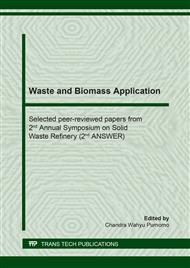[1]
K. Pimapunsri, T. Wuttipornpun, D. Veeranant, A Study of the Factors Affecting the Separation Force of Artificial Leather Laminating Process, Key Engineering Materials. 728 (2017) 307–312. https://doi.org/10.4028/www.scientific.net/KEM.728.307.
DOI: 10.4028/www.scientific.net/kem.728.307
Google Scholar
[2]
C. Yang, J. Wang, L. Li, A novel approach for developing high thermal conductive artificial leather by utilizing smart electronic materials, Textile Research Journal. 87 (2017) 816–828. https://doi.org/10.1177/0040517516641356.
DOI: 10.1177/0040517516641356
Google Scholar
[3]
E.K. Roh, K.W. Oh, S.H. Kim, Effect of raising cycles on mechanical, comfort, and hand properties of artificial suede, Textile Research Journal. 84 (2014) 1995–2005. https://doi.org/10.1177/0040517514528561.
DOI: 10.1177/0040517514528561
Google Scholar
[4]
D. Gurera, B. Bhushan, Fabrication of bioinspired superliquiphobic synthetic leather with self-cleaning and low adhesion, Colloids and Surfaces A: Physicochemical and Engineering Aspects. 545 (2018) 130–137. https://doi.org/10.1016/j.colsurfa.2018.02.052.
DOI: 10.1016/j.colsurfa.2018.02.052
Google Scholar
[5]
G.V. Rybachuk, I.I. Kozlova, V.B. Mozzhukhin, V.V. Guzeev, PVC plastisols: Preparation, properties, and application, Polym. Sci. Ser. C. 49 (2007) 6–12. https://doi.org/10.1134/S181123820701002X.
DOI: 10.1134/s181123820701002x
Google Scholar
[6]
A. Zadhoush, M.A. Alsharif, P.E. Alsharif, The Influence of K-Value and Plasticizer Type on the Rheological Behaviour of Plastisol Used in Coated Fabrics, Iranian Polymer Journal. 13 (2004) 371–379.
DOI: 10.1106/rh63-xfvg-wytr-fqnp
Google Scholar
[7]
I. Maia, J. Santos, M. Abreu, T. Miranda, N. Carneiro, G. Soares, PVC-based synthetic leather to provide more comfortable and sustainable vehicles, IOP Conf. Ser.: Mater. Sci. Eng. 254 (2017) 122006. https://doi.org/10.1088/1757-899X/254/12/122006.
DOI: 10.1088/1757-899x/254/12/122006
Google Scholar
[8]
S. Joneydi, A. Khoddami, A. Zadhoush, Novel superhydrophobic top coating on surface modified PVC-coated fabric, Progress in Organic Coatings. 76 (2013) 821–826. https://doi.org/10.1016/j.porgcoat.2013.01.011.
DOI: 10.1016/j.porgcoat.2013.01.011
Google Scholar
[9]
J. Donate-Robles, J.M. Martín-Martínez, Addition of precipitated calcium carbonate filler to thermoplastic polyurethane adhesives, International Journal of Adhesion and Adhesives. 31 (2011) 795–804. https://doi.org/10.1016/j.ijadhadh.2011.07.008.
DOI: 10.1016/j.ijadhadh.2011.07.008
Google Scholar
[10]
J.A. Brydson, Plastic Materials, 7th ed., Butterworth-Heinemann, Oxford, (1999).
Google Scholar
[11]
Ł. Klapiszewski, F. Pawlak, J. Tomaszewska, T. Jesionowski, Preparation and Characterization of Novel PVC/Silica–Lignin Composites, Polymers. 7 (2015) 1767–1788. https://doi.org/10.3390/polym7091482.
DOI: 10.3390/polym7091482
Google Scholar
[12]
R.N. Rothon, Particulate Fillers for Polymers, iSmithers Rapra Publishing, (2002).
Google Scholar
[13]
D.B. van den Heuvel, E. Gunnlaugsson, I. Gunnarsson, T.M. Stawski, C.L. Peacock, L.G. Benning, Understanding amorphous silica scaling under well-constrained conditions inside geothermal pipelines, Geothermics. 76 (2018) 231–241. https://doi.org/10.1016/j.geothermics.2018.07.006.
DOI: 10.1016/j.geothermics.2018.07.006
Google Scholar
[14]
M. Olvianas, A. Widiyatmoko, H.T.B. Petrus, IR Spectral Similarity Studies of Geothermal SilicaBentonite Based Geopolymer, in: Green Construction and Engineering Education for Sustainable Future, 2017. https://doi.org/10.1063/1.5003498.
DOI: 10.1063/1.5003498
Google Scholar
[15]
J.A. Villarias, M.L.H. Yorro, M.-I.K.N. Galvan, L.J.L. Diaz, High Purity Silica Nanoparticles from Geothermal Waste Brine as Reinforcing Filler in Rubber Composite Material, Materials Science Forum. 894 (2017) 104-108. https://doi.org/10.4028/www.scientific.net/MSF.894.104.
DOI: 10.4028/www.scientific.net/msf.894.104
Google Scholar
[16]
E.J. Kim, I.K. Paik, J.H. Park, Preparation and adhesion properties of waterborne polyurethane-coated resin for synthetic leather, in: California, USA, 2019: p.030005. https://doi.org/10.1063/1.5094315.
DOI: 10.1063/1.5094315
Google Scholar
[17]
O.G.M. Sandoval, A.E.L. Orozco, S. Valenzuela, G.C.D. Trujillo, Modified amorphous silica from a geothermal central as a metal adsorption agent for the regeneration of wastewater, Water Resources and Industry. 21 (2019) 100–105. https://doi.org/10.1016/j.wri.2018.100105.
DOI: 10.1016/j.wri.2018.100105
Google Scholar


